SEO Checker
On-Page SEO is the process of optimizing your website to help search engines understand what your page is about. The goal is to get your page to appear in the search results when someone searches for the keywords that are relevant to your business.
The first step in on-page optimization is choosing a target keyword. This is the word or phrase that you want people searching for when they find your site. Once you know what words people are using to find you, you can optimize your site for those words by adding them to your site’s copy and title tags, as well as developing content around those keywords.
On-Page Seo Checker
Analyze any web page with the free SEO checker by Seobility to find technical errors and on-page SEO issues that might be holding your site back from top search engine rankings.
Get your free SEO score as well as individual sub-scores for each of the categories checked, including meta-information, page quality, page structure, link structure, server configuration, and external factors.
With your prioritized task list of SEO improvements, you will immediately know where to start to achieve quick and noticeable results.

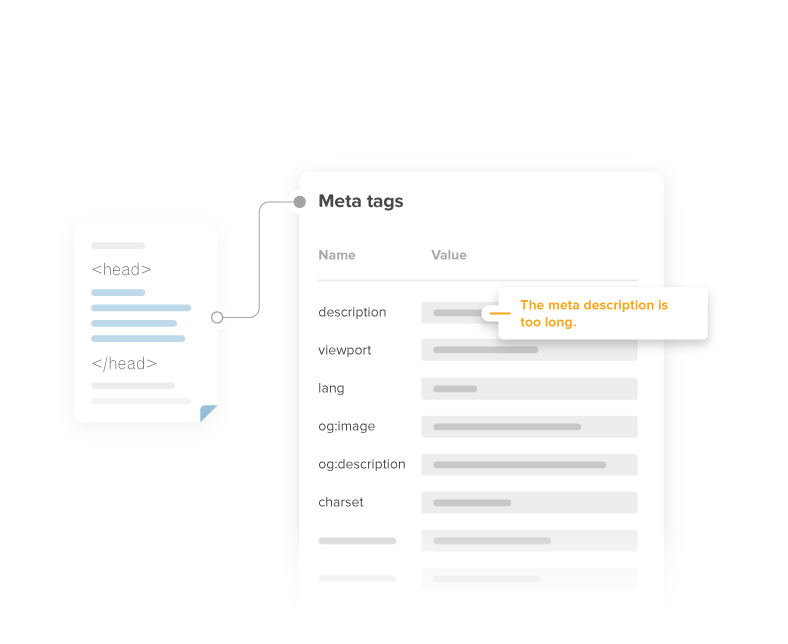
Meta information
Don’t let search engines do the guesswork
To make sure that search engines understand what your website is about, you have to provide meta-information that helps them categorize your content.
The Seobility SEO Checker identifies errors and SEO issues in your meta-information, such as:
- meta titles and descriptions that are too short or too long for the search result snippet
- meta tags that prevent search engines from indexing your website
- missing canonical links
- inconsistent language declarations
- problematic domain names or page URLs
Page quality
Unfold the full potential of your content
High-quality content is one of the most important SEO success factors. To help search engines process your content and rank it for relevant keywords, you should avoid page quality issues such as:
- too little text on one page
- duplicate content
- outdated website elements such as framesets
- poor optimization for mobile devices
- images without alt attributes
- ads that overlay your content
Check these and other potential issues with the SEO Checker to eliminate all quality problems that are holding your content down!
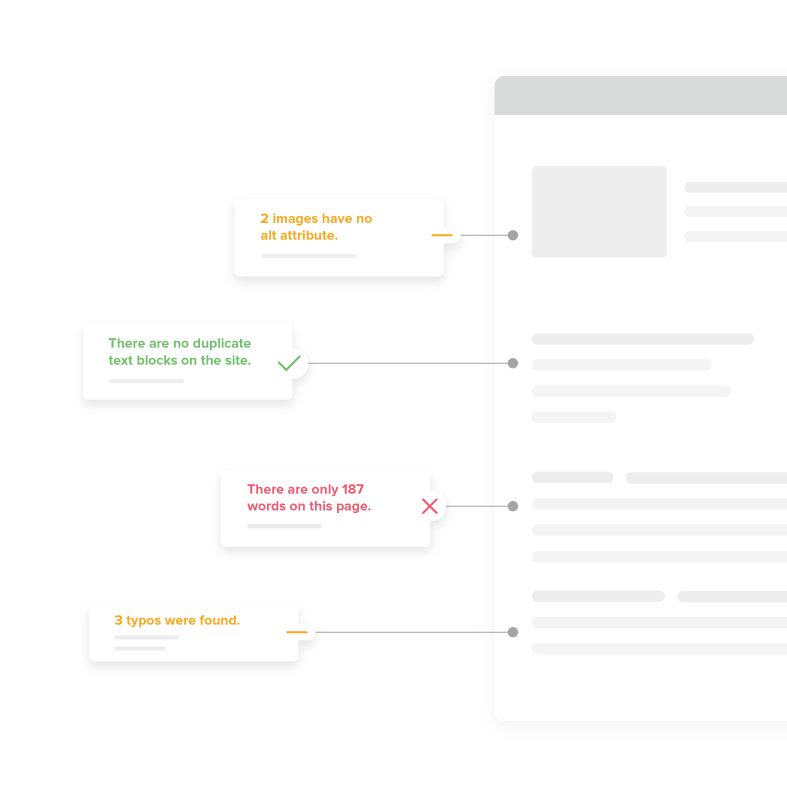
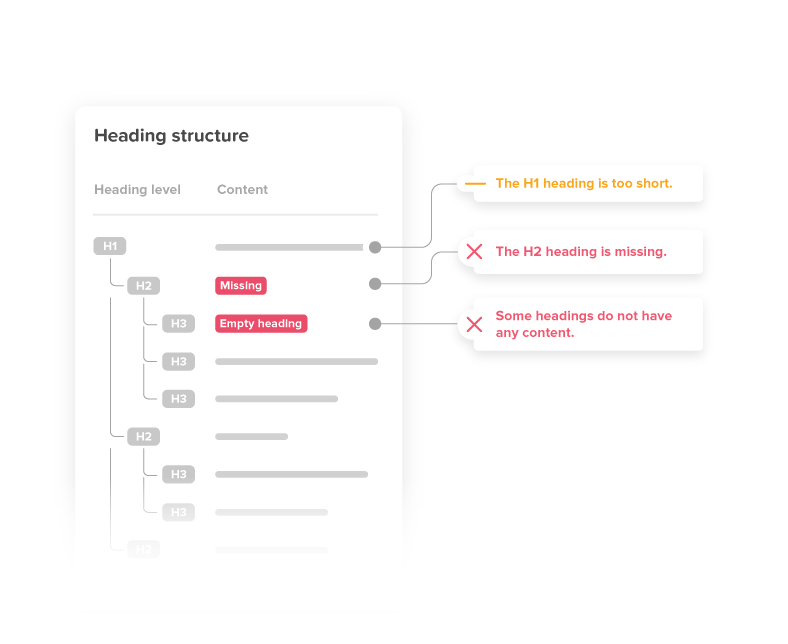
Page and link structure
Let search engines move through your website with ease
Search engines prefer websites that are clearly structured and enable efficient crawling.
The SEO Checker identifies problems that make it difficult for search engines to analyze your website, including:
- H1 headings that are too short or too long
- wrong order of headings or empty heading tags
- internal links with dynamic parameters
- duplicate anchor texts of internal links
- unfavorable amount of internal or external links
Server configuration
The technical setup of your website is essential
An error-free and high-performing technical setup makes it easy for search engines to crawl your website. It is a necessity for achieving top rankings.
The SEO Checker will scan your web page for server errors and other technical issues like:
- wrongly configured redirect between www and non-www subdomains
- problems with your HTTP header
- long page response times
- high number of CSS and JavaScript files
- big HTML file size
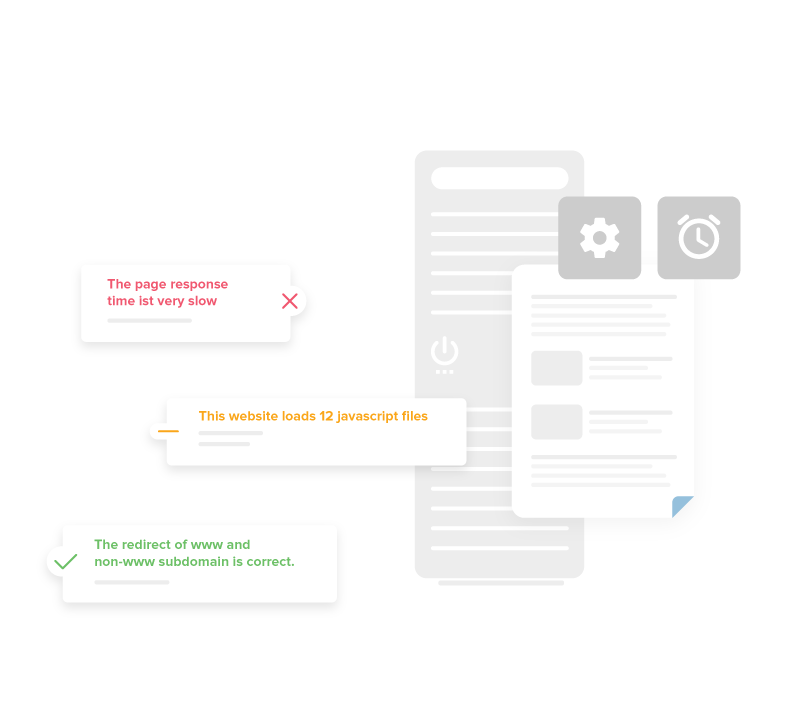
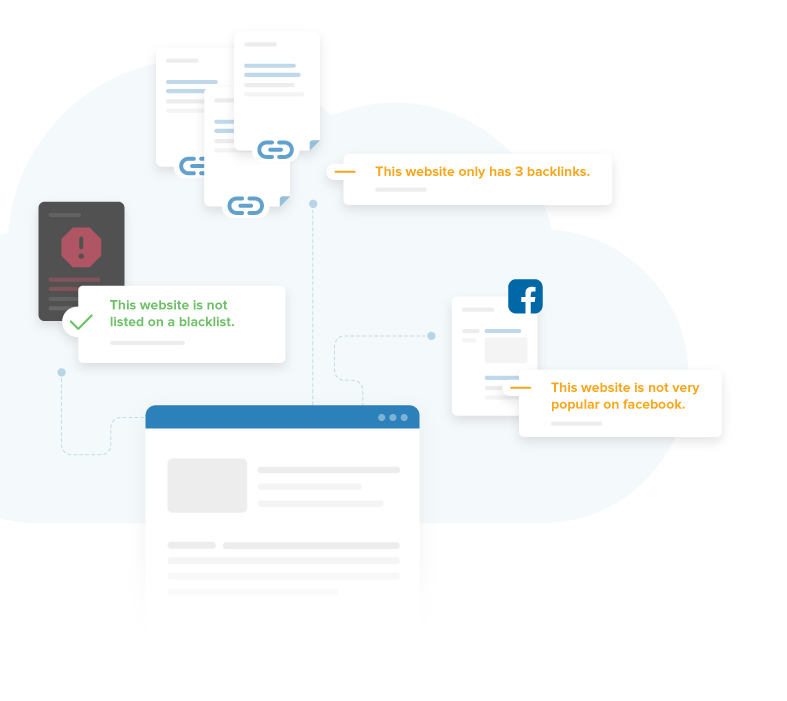
External factors
Get the full picture of ranking factors
Search engine optimization is not only about optimizing the website itself. For long-term SEO success, you also have to keep an eye on external factors that influence your search engine rankings.
With the SEO checker, you can easily identify weaknesses your website might have in the following areas:
- Blacklists: Is your website listed on a blacklist that prevents it from being displayed in search results?
- Backlinks: Backlinks signal to search engines that your website is recommended by other sites and offers valuable content. Does your website have enough links from multiple sources?
- Social Media: Is your website shared on social media?
 Check your website now!
Check your website now!
Do you want to check more than just one single page?
The free Seobility plan already includes a comprehensive SEO site audit for up to 1,000 subpages! Learn more.Frequently Asked Questions
Everything you have to know about the SEO CheckerWhat is an SEO checker?
The Seobility SEO checker is a tool that scans any web page for technical errors and SEO issues that can have a negative impact on search engine rankings. Use it to get a comprehensive list of errors found on your web page and find out where you still have to improve your website.How does an SEO checker work?
The Seobility SEO checker crawls the URL you enter, similar to how search engines work. The page is then checked against more than 200 SEO relevant criteria: meta information, page quality, site structure, and others. Based on how well your website performs regarding these criteria, an individual SEO score is calculated and shown together with a complete list of errors found on your site.What does an SEO checker analyze?
The Seobility SEO checker analyzes if your website meets criteria search engines use to determine your website’s ranking in search results. In order to do that more than 200 parameters in the categories of meta-information, page quality, page structure, link structure, server configuration, and external factors are checked and results are considered when calculating the SEO score.What is an SEO score?
The individual SEO score of your website indicates how well the web page complies with search engines’ quality guidelines. One can roughly say, that if the score is higher than 80% it means that the web page is already well-optimized whereas a score below 80% shows that there’s still room for improvement. If the score is below 30% there are severe errors and SEO issues on your website you should definitely deal with.Can I download a PDF with the results?
Yes, you can download a PDF file with your SEO check results by clicking on the “PDF Export” button right at the top of the results page. You can choose between a short and a complete version of the report and even upload your company logo to generate a personalized report. Please note that this is a feature of the Seobility Premium plan.How can I improve my SEO score?
You can improve your SEO score by fixing the errors and issues that the Seobility SEO checker found on your website. The task list of SEO improvements will show you which issues are the most important ones as eliminating them will have a noticeable impact on your SEO performance. Those are the tasks that you should first tackle when starting with the optimization of your website.How can I check my SEO ranking?
There are several online tools you can use to check your rankings, e.g. the Seobility Ranking Checker. Just enter your domain and the search term you want to check. The tool will immediately display your domain’s ranking as well as the top 100 URLs ranking for this keyword.
what is on page seo techniques
Succeeding in organic search today requires optimizing for a combination of factors that search engines consider important – technical, on-page and off-page.
Over the years, we’ve seen increased focus toward off-page techniques – such as link building – and other technical elements.
But the reality is, off-page SEO won’t do much good if you don’t pay attention to the fundamentals – on-page SEO.
Smart SEO practitioners know that on-page optimization should be constantly prioritized.
And because the search landscape is ever-evolving, it’s important to make sure your on-page SEO knowledge is up to date.
In this post, we will cover what on-page SEO is, why it matters, and 10 of the most important on-page SEO considerations today.
What Is On-Page SEO?
On-page SEO (also known as on-site SEO) refers to the practice of optimizing web pages to improve a website’s search engine rankings and earn organic traffic.
In addition to publishing relevant, high-quality content, on-page SEO includes optimizing your headlines, HTML tags (title, meta, and header), and images. It also means making sure your website has a high level of expertise, authoritativeness, and trustworthiness.
It takes into account various aspects of the webpage that, when added together, will improve your website’s visibility in the search results.
Why On-Page SEO Is Important
On-page SEO is important because it helps search engines understand your website and its content, as well as identify whether it is relevant to a searcher’s query.
As search engines become more sophisticated, there is a greater focus toward relevance and semantics in search engine results pages (SERPs).
Google, with its plethora of complex algorithms, is now much better at:
- Understanding what users are actually searching for when they type a query.
- Delivering search results that meet user intent (informational, shopping, navigational).
Adapting to this development is essential, and you can do it by ensuring that your website and its content – both what is visible to users on your webpages (i.e., text, images, video, or audio) and elements that are only visible to search engines (i.e., HTML tags, structured data) – are well-optimized according to the latest best practices.
Additionally, you can’t simply ignore on-page SEO because you have more control when optimizing for on-site elements – as opposed to off-page SEO that consists of external signals (i.e., backlinks).
If you put effort into on-page strategies, you’ll see a boost in traffic and a rise in your search presence.
This guide will walk you through the most important elements of on-page SEO.
Paying close attention to these 10 areas will help improve your content and authority – and increase your rankings, traffic, and conversions.
1. E-A-T
E-A-T, which stands for Expertise, Authoritativeness, and Trustworthiness, is the framework that Google raters use to assess content creators, webpages, and websites as a whole.
Google has always put a premium on high-quality content. It wants to make sure that sites producing high-quality content are rewarded with better rankings and sites that create low-quality content get less visibility.
There is a clear relationship between what Google considers high-quality content and what appears in the search results.
Grow Your Business With Vetted Freelancers Today
Fiverr Business gives your team the tools to collaborate and delegate with the world’s largest selection of talented freelancers for any need.Get StartedADVERTISEMENT
Call it correlation or causation – whatever it is, E-A-T is somehow playing a role in Google’s organic search results. Which means E-A-T must be a consideration in your SEO strategy.
2. Title Tag
The title tag, an HTML tag that exists in the head section of each webpage, provides an initial cue or context as to what the topical subject matter is of the respective page it is on.
It is featured prominently in the search engine results pages (typically used as the clickable link) as well as in the browser window.
The title tag by itself has little impact on organic rankings, this why it’s sometimes overlooked.
That said, missing, duplicate, and poorly written title tags can all negatively impact your SEO results, so make sure you’re optimizing for this element.
3. Meta Description
Since the early days of SEO, meta descriptions have been an important optimization point.
Meta descriptions, meta tags that provide a description of what the page is about, are often displayed in the SERPs underneath the title of the page.
While Google maintains that meta descriptions don’t help with rankings, there is anecdotal evidence that indirect attributes of better descriptions do help.
Optimizing meta description correctly can help improve:
- Click-through rate (CTR).
- Perception of the quality of the result.
- Perception of what your website offers all change.
4. Headlines
Want your website content to perform well on search? Then start writing compelling headlines.
Coming up with a title for a blog post might seem too basic, but a great headline can mean the difference between a click and an impression – that’s why it’s important to create them strategically.
Your headlines need to spark interest for it to stand out on the SERPs – enticing users to click through and continue reading the rest of the content.
5. Header Tags
Header tags are HTML elements (H1-H6) used to identify headings and subheadings within your content from other types of text (e.g., paragraph text).
Header tags aren’t as critically important for your site rankings as they used to be, but these tags still serve an important function – for your users and your SEO.
They can indirectly impact your rankings by:
- Making your content easier and more enjoyable for visitors to read.
- Providing keyword-rich context about your content for the search engines.
6. SEO Writing
SEO writing means writing content with both search engines and users in mind.
There is a strategy behind writing solid SEO content – and it is more than just keyword research and fill in the blanks.
Simply producing content for the sake of it won’t do. Remember that you’re writing content for people – therefore that content must be high-quality, substantial, and relevant.
7. Keyword Cannibalization
True or false? The more pages you have targeting a keyword, the better you’ll rank for that keyword.
False!
Targeting a specific term across multiple pages can cause “keyword cannibalization” which has some potentially disastrous consequences for your SEO.
When you have multiple pages ranking for the same keyword, you’re actually competing with yourself.
It’s important to identify whether keyword cannibalization exists on your website and resolve it right away.
8. Content Audit
Most content creators are focused on creating new content that they forget to audit their existing content. And this is a mistake.
Auditing your existing content is crucial because it helps you:
- Evaluate whether your existing content is achieving its goals and gaining ROI.
- Identify whether the information in your content is still accurate or has become stale (or even outdated).
- Determine what types of content are working for you.
Content audits can greatly help your SEO strategy and they should be done on a regular basis.
9. Image Optimization
Adding images is a good way to make your webpages more appealing. But not all images are created equal – some can even slow down your website.
Optimizing images properly will help you make the most of a valuable SEO asset.
Image optimization has many advantages, such as:
- Additional ranking opportunities (show up on Google Image Search).
- Better user experience.
- Faster page load times.
Images shouldn’t be an afterthought. Make sure to incorporate images that support your content and use descriptive titles and alt text.
10. User Engagement
Enhancing your website’s on-page SEO elements is only half the battle.
The other half lies in making sure that users will not bounce – but instead, they’ll continue viewing your content, interacting with it, and keep coming back for more.
Retaining engaged users is a great challenge in itself, but it’s certainly doable. To increase user engagement, focus on aspects such as site speed, user experience, and content optimization, among others.
Conclusion
On-page SEO is important if you want to increase your website’s chances of showing up in the search results.
Optimizing for on-site factors on a regular basis can help improve your rankings, traffic, and conversions.
Conclusion
Let us know your thoughts in the comment section below.
Check out other publications to gain access to more digital resources if you are just starting out with Flux Resource.
Also contact us today to optimize your business(s)/Brand(s) for Search Engines
